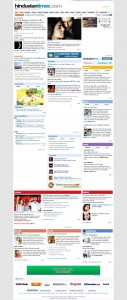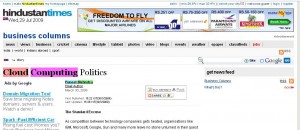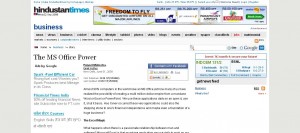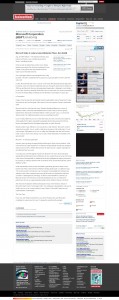Published on 25th September, 2009, HindustanTimes Homepage
Orkut Zeitgeist tells us what Indians are doing online. And the word is that Indians are having fun. While sex rules a substantial portion of web traffic, surprisingly social networking in India seems to be on a higher energy level and carnal desires figure no where.
Lies, damned lies and statistics. That’s how I have usually treated statistics. Before you jump I do have valid reasons. A sample size of or 2000 or 4000 or even 200000 can in no way predict or tell what over 40 million people are doing. It is almost impossible to predict trends when the market is so large. And lastly I am a firm believer that just because somebody says something it means nothing. If it did we would still have 484 kb memory laptops (Bill Gates famous quote “484 kb memory should be enough”), Fax machines would have 10 world wide users and Computers still processing in acre big institutional lands.
Having said that recently I came across an interesting research that truly did seem interesting. Social networking is in and that’s where the majority of web users are these days. Social networking is also the single largest generators of Indian web traffic are the best place to check out what India’s youth are up to online. I always wondered what are Indians doing on social networking sites? While sex rules the search market and a substantial portion of web traffic, surprisingly social networking in India seems to be on a higher energy level and carnal desires figure no where.
The study I am referring to is Orkut Zeitgeist, which was released by Google recently. The credibility of the study is relevant because Orkut is India’s no. 1 web property with over 19 million active users (users who login at least once a month). This is 48% of India’s online population. Now 48% certainly is some sample size and certainly the biggest to study and research trends.
The Pulse of Indians
Consider the case of the Top National Communities on Orkut. The features communities like ‘Stylish people’, ‘India’, ‘Chocolate’, ‘MTV’, ‘Tom and Jerry’ and even communities like “I hate to wake up early!” Sex directly or indirectly doesn’t figure anywhere in the top communities.
Regionally while Delhi is not only the Style capital of India it also turned out to the sweet center with its Chocolate community.
The study goes to the microscopic level of “Geri route” in Chandigarh. Now anyone who has been to Chandigarh knows about the “geri” and something as regional and microscopic as this finds a mention in this study of 48% of Indians online. This is perhaps one of the reasons it is definitely one of the best studies ever done on online Indians.
Accessibility
Most marketers have been very keen to know how are Indians accessing the internet. Well according to the study Orkut (read 48% of India’s online population) is accessed from everywhere: more and more users logging from their mobiles.
Corporate Indians gets hooked to Social Networking
Sony Ericsson, MTV, TCS, Bollywood all seemed to be hooked to social networking. Take the case of MTV Roadies. The application allows the users of Orkut to play an online version of the game and at the end any one person is chosen the winner who then gets a direct entry to the auditions round of the next MTV Roadies. With over 3 lac users registered to the Battleground 2, it surely is a big hit.
Or take the case of Cadburys. Cadburys now synonymous with festivals like Rakhi, Eid and Diwali is seen as the best gift amongst youngsters. With this application, in a very subtle way Cadburys has further rubbed in that a gift pack of chocolates from Cadburys is indeed the top in anyone’s wish list. This application on Orkut invites users to create their own wish list, share it with friends ask their friends to create their wish list and then mutually try and fulfill any one of these.
The Last Word
Orkut Zeitgeist is probably the best study available on what Indians are doing online. 48% on India’s online population are active users on Orkut and that’s probably the closest one can get to reality. Indians are having fun. Social networking in India is about forging bonds, about self expression and coming together on causes and topics that bind people together.
(Puneet Mehrotra writes on technology www.thebusinessedition.com
You can write to him at puneet@tbe.in)





